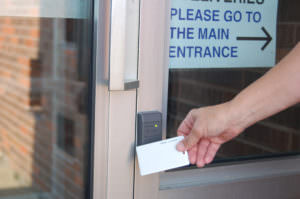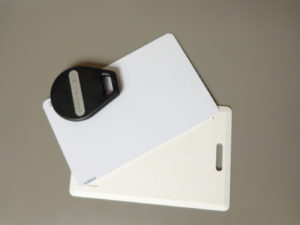
Security card access systems, or card entry systems, give businesses control of who gains access to the physical locations of their business or certain areas within their business.
Employee access is allowed through proximity cards. Employees move their card in front of the reader, and the code is “securely and instantly transmitted from the card to the reader via a radio signal. If the system recognizes the signal as an authorized entry, it automatically releases the magnetic lock or door strike holding the door shut” (DPS Telecom). While magnetic stripe cards were typically used in the past, there has been a movement away from them as they could be copied or stop working if the magnetic strip was damaged. New I-class cards form a “handshake” with the reader, exchanging information back and forth up to 4 times, making them much harder to copy.

Two common types of proximity cards are clamshell and printable cards. Clamshell is generally cheaper, but printable cards allow for double usage with the ability to create photo IDs on one side.
A similar access control alternative to a proximity card is a key fob. Smaller than a proximity card, key fobs can be more convenient, as a fob can go with your other keys rather than a card that may be stored in a wallet or purse.
Individually Programmed
Entry cards are programmed for each individual, allowing businesses the option of granting complete access or limited access during scheduled times. For example, a business could grant full access to managers, but limit access for employees to the hours of 7:30 a.m. to 5:30 p.m. With an access control system, businesses can also schedule automatic unlocking of the doors in the morning and locking of the doors in the evening, preventing your building from being unsecured when an employee forgets to lock a door. These systems take holidays into account as well as factoring in time changes during Daylight Savings Time.
Video surveillance is often paired with access control systems in order to determine whether it is the authorized person entering the building (and not someone using a stolen card). If using a combined video surveillance system, when the card meets the reader, a link is created into the digital video recorder (DVR) or network video recorder (NVR). to pull up information about that specific door access.
A card access system can generally maintain information about hundreds of cards, although systems can be customized based on smaller or greater access needs.
External and Internal Use
Typically, access control systems are used on external doors for storage facilities, manufacturing sites, college dorms, and other businesses that need to provide limited access to their facilities. Another way card external access control systems are used is in parking garages. This kind of system can require an entrance and exit before the same card can be used again in order to control limited parking.
Internal doors can also have card access systems, controlling access to highly sensitive or sensitive areas such as hospital supply rooms, guard shacks, or IT areas. Schools also use them for classrooms to prevent theft, to restrict access to computer labs, and in case of a threat situation, enabling them to lock all the doors at one time.
Elevators are another spot for an internal card entry system. For example, an apartment building can restrict access for a resident who lives on the 5th floor to only that floor and the main level. Elevator card access is also very common for jails and courthouses to restrict access to certain levels.
Record-Keeping
With a card access system, businesses can keep a record of who enters and when they entered. If there are problems or thefts within the business that can be narrowed to a specific day or time, these records can determine who had access to the building during those times. This information can also be used to cross-check employee start and end times as well as attendance. Typical stored information includes:
- Date and time of credential read
- Name of credential holder
- Unique ID number or badge number
- Name of door or reader being accessed
- Access granted/denied condition
This information can be stored on a server capable of holding up to several years of history. Many businesses desire this kind of audit trail, especially banks and those with secured IT rooms.
Multiple locations can also be monitored from 1 location or server. For example, a company with facilities in the U.S. and abroad could monitor all their locations from a centralized main office. Cities often use this option to keep track of several buildings throughout a large area.
Terminating Employee Access
Another benefit of a card access system includes the ease of terminating access. With a lock and key system, when a key was lost or kept after an employee was terminated, the entire facility would need to be rekeyed in order to prevent unauthorized access. With many access points into the average building, this can be a very expensive process.
Proximity cards are difficult to reproduce and easy to deactivate, should someone’s access need to be revoked. To enable or revoke access, an authorized person simply accesses the credential manager or other management tool and adds or deletes a card.
Churches and businesses with transient populations or high turnover rates can use card access control systems to easily add or remove access as needed, rather than trying to keep track of keys.
Many businesses choose to secure their buildings through key card access systems. These can be convenient and more secure than standard lock and key systems. However, with a key card access control system, because the locks are electrified, it is important to have back-up physical keys in case of a power outage or dead batteries.
Sources: IPVM – Video Surveillance/Access Control Integration, IPVM – Designing Access Control Guide

